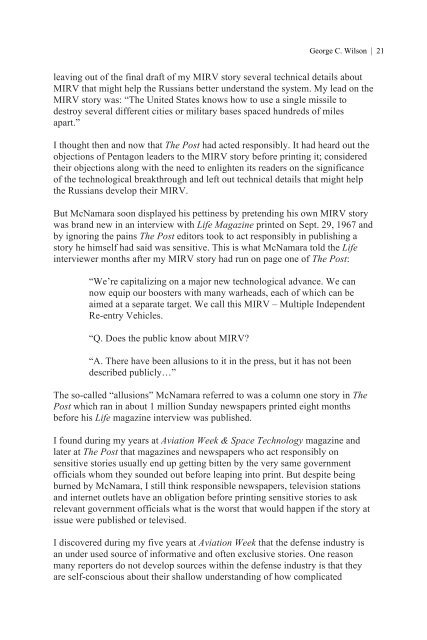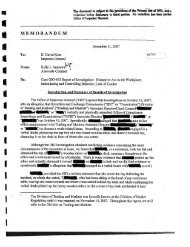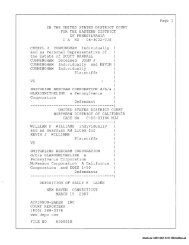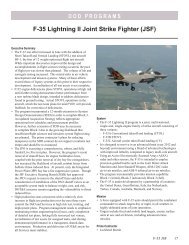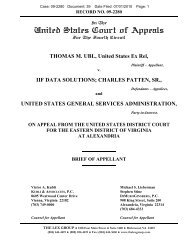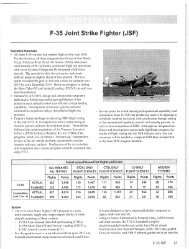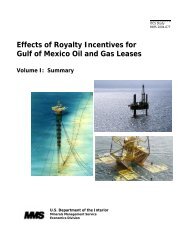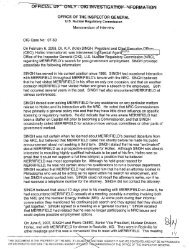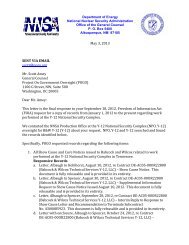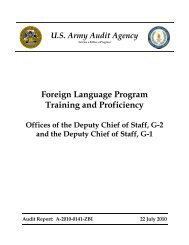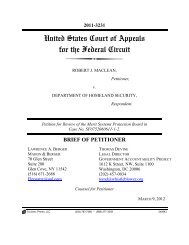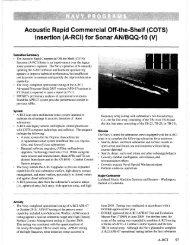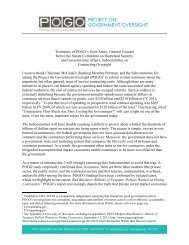The Pentagon Labyrinth
The Pentagon Labyrinth
The Pentagon Labyrinth
You also want an ePaper? Increase the reach of your titles
YUMPU automatically turns print PDFs into web optimized ePapers that Google loves.
leaving out of the final draft of my MIRV story several technical details about<br />
MIRV that might help the Russians better understand the system. My lead on the<br />
MIRV story was: “<strong>The</strong> United States knows how to use a single missile to<br />
destroy several different cities or military bases spaced hundreds of miles<br />
apart.”<br />
I thought then and now that <strong>The</strong> Post had acted responsibly. It had heard out the<br />
objections of <strong>Pentagon</strong> leaders to the MIRV story before printing it; considered<br />
their objections along with the need to enlighten its readers on the significance<br />
of the technological breakthrough and left out technical details that might help<br />
the Russians develop their MIRV.<br />
But McNamara soon displayed his pettiness by pretending his own MIRV story<br />
was brand new in an interview with Life Magazine printed on Sept. 29, 1967 and<br />
by ignoring the pains <strong>The</strong> Post editors took to act responsibly in publishing a<br />
story he himself had said was sensitive. This is what McNamara told the Life<br />
interviewer months after my MIRV story had run on page one of <strong>The</strong> Post:<br />
“We’re capitalizing on a major new technological advance. We can<br />
now equip our boosters with many warheads, each of which can be<br />
aimed at a separate target. We call this MIRV – Multiple Independent<br />
Re-entry Vehicles.<br />
“Q. Does the public know about MIRV?<br />
George C. Wilson | 21<br />
“A. <strong>The</strong>re have been allusions to it in the press, but it has not been<br />
described publicly…”<br />
<strong>The</strong> so-called “allusions” McNamara referred to was a column one story in <strong>The</strong><br />
Post which ran in about 1 million Sunday newspapers printed eight months<br />
before his Life magazine interview was published.<br />
I found during my years at Aviation Week & Space Technology magazine and<br />
later at <strong>The</strong> Post that magazines and newspapers who act responsibly on<br />
sensitive stories usually end up getting bitten by the very same government<br />
officials whom they sounded out before leaping into print. But despite being<br />
burned by McNamara, I still think responsible newspapers, television stations<br />
and internet outlets have an obligation before printing sensitive stories to ask<br />
relevant government officials what is the worst that would happen if the story at<br />
issue were published or televised.<br />
I discovered during my five years at Aviation Week that the defense industry is<br />
an under used source of informative and often exclusive stories. One reason<br />
many reporters do not develop sources within the defense industry is that they<br />
are self-conscious about their shallow understanding of how complicated


